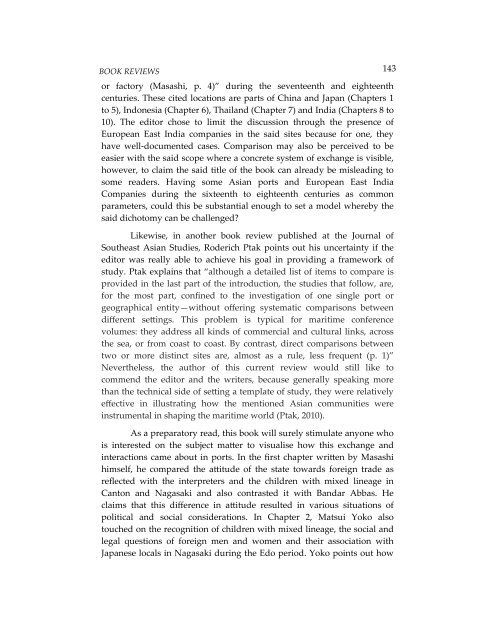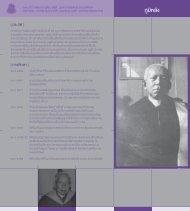You also want an ePaper? Increase the reach of your titles
YUMPU automatically turns print PDFs into web optimized ePapers that Google loves.
BOOK REVIEWS 143or factory (Masashi, p. 4)” during the seventeenth and eighteenthcenturies. These cited locations are parts of China and Japan (Chapters 1to 5), Indonesia (Chapter 6), Thailand (Chapter 7) and India (Chapters 8 to10). The editor chose to limit the discussion through the presence ofEuropean East India companies in the said sites because for one, theyhave well-documented cases. Comparison may also be perceived to beeasier with the said scope where a concrete system of exchange is visible,however, to claim the said title of the book can already be misleading tosome readers. Having some Asian ports and European East IndiaCompanies during the sixteenth to eighteenth centuries as commonparameters, could this be substantial enough to set a model whereby thesaid dichotomy can be challenged?Likewise, in another book review published at the Journal ofSoutheast Asian Studies, Roderich Ptak points out his uncertainty if theeditor was really able to achieve his goal in providing a framework ofstudy. Ptak explains that “although a detailed list of items to compare isprovided in the last part of the introduction, the studies that follow, are,for the most part, confined to the investigation of one single port orgeographical entity—without offering systematic comparisons betweendifferent settings. This problem is typical for maritime conferencevolumes: they address all kinds of commercial and cultural links, acrossthe sea, or from coast to coast. By contrast, direct comparisons betweentwo or more distinct sites are, almost as a rule, less frequent (p. 1)”Nevertheless, the author of this current review would still like tocommend the editor and the writers, because generally speaking morethan the technical side of setting a template of study, they were relativelyeffective in illustrating how the mentioned Asian communities wereinstrumental in shaping the maritime world (Ptak, 2010).As a preparatory read, this book will surely stimulate anyone whois interested on the subject matter to visualise how this exchange andinteractions came about in ports. In the first chapter written by Masashihimself, he compared the attitude of the state towards foreign trade asreflected with the interpreters and the children with mixed lineage inCanton and Nagasaki and also contrasted it with Bandar Abbas. Heclaims that this difference in attitude resulted in various situations ofpolitical and social considerations. In Chapter 2, Matsui Yoko alsotouched on the recognition of children with mixed lineage, the social andlegal questions of foreign men and women and their association withJapanese locals in Nagasaki during the Edo period. Yoko points out how



